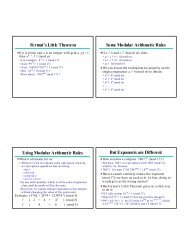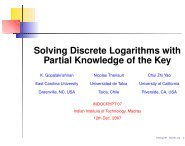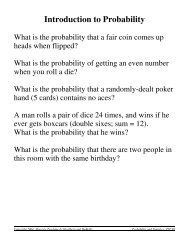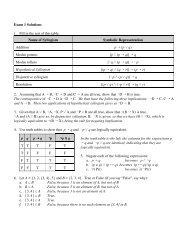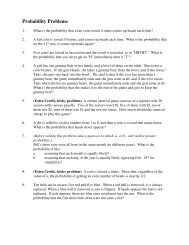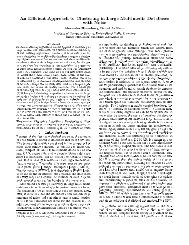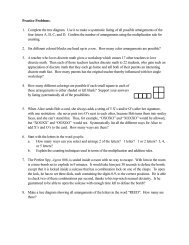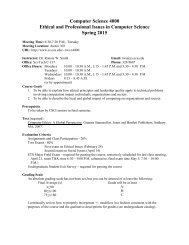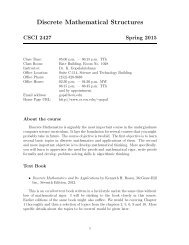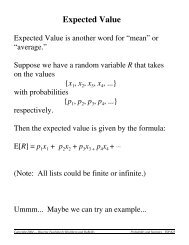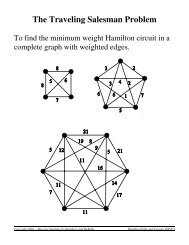Discrete Mathematics Name: Answers Exam 1 February 18, 2009 1 ...
Discrete Mathematics Name: Answers Exam 1 February 18, 2009 1 ...
Discrete Mathematics Name: Answers Exam 1 February 18, 2009 1 ...
Create successful ePaper yourself
Turn your PDF publications into a flip-book with our unique Google optimized e-Paper software.
<strong>Discrete</strong> <strong>Mathematics</strong><br />
<strong>Name</strong>: <strong>Answers</strong><br />
<strong>Exam</strong> 1 <strong>February</strong> <strong>18</strong>, <strong>2009</strong><br />
1. For each of the figures shown below, please indicate whether they have an Euler path, an Euler circuit,<br />
both or neither.<br />
This one has<br />
more than two<br />
odd vertices, so<br />
NEITHER.<br />
This one has two<br />
odd vertices, so<br />
PATH<br />
This one has two<br />
odd vertices, so<br />
PATH<br />
This one has no<br />
odd vertices, so<br />
PATH and<br />
CIRCUIT<br />
2. When will a graph have an Euler circuit? When all of its vertices have even degree.<br />
3. What about a graph will guarantee that it has neither an Euler circuit nor an Euler path? If it has more<br />
than two odd vertices.<br />
4. G is a graph that has 20 vertices, and all of them have degree five. How many edges does this graph<br />
have? Explain your answer. It will have 20 × 5 / 2 = 50 edges<br />
5. Give a proof that a graph cannot have exactly one vertex of odd degree, regardless of how many vertices<br />
it has of even degree.<br />
Proof 1: Since the sum of the degrees is equal to twice the number of edges, it follows that the sum of<br />
the degrees must be even. But if there was exactly one odd vertex, this sum would be odd.<br />
Contradiction.<br />
Proof 2: If you construct the graph by starting with vertices only, and no edges, then you start with a<br />
graph in which all vertices have even degree. Then add the edges one at a time. Each time you add an<br />
edge, you change the parity of the two vertices incident with the edge. Thus each time you add an edge,<br />
the number of odd vertices must either go up by 2, down by 2 or stay the same. This implies that the<br />
number of odd vertices must remain even.<br />
6. Prove that if T is a tree and u and v are two vertices in T, then there is a path from u to v in T.<br />
Proof: If T is a tree, then it is connected and has no cycles, by definition of tree. And by definition of<br />
connected, there will be a path between any pair of vertices in T, including u and v.
7. Suppose that G is a tree and uv is an edge in G connecting vertices u and v. Suppose we remove the<br />
edge uv from G. Prove that the resulting graph will not have a path from u to v.<br />
Proof: (By contradiction.) Suppose there was a path from u to v in the resulting graph. Then if we put<br />
the edge uv back, we will have found a cycle in the original graph G. But G is a tree, and must therefore<br />
have no cycles. Contradiction.<br />
<br />
8. Find a minimum weight spanning tree in the graph below: (Two copies are given. Please cross out the<br />
one that you don’t want graded.)<br />
9. Describe in words the method you used to find the minimum weight spanning tree in the previous<br />
problem. (Don’t merely say “Kruskal’s algorithm” or “Prim’s algorithm.” Say a few words about how<br />
you use the algorithm.)<br />
Kruskal’s Algorithm: At each step select the edge of minimum weight that will not create a cycle.<br />
Stop when you have a spanning tree.<br />
Prim’s Algorithm: Select a start vertex, v, and call this your tree so far. At each step, select the edge<br />
incident with your tree so far having minimum weight, but without creating a cycle. Stop when your tree<br />
contains all vertices of the graph.<br />
10. Prove that p v ¬q is logically equivalent to ¬(q w ¬p). The boxed columns below are identical.<br />
p q ¬q p v ¬q ¬p q w ¬p ¬(q w ¬p)<br />
t t f f f t f<br />
t f t t f f t<br />
f t f f t t f<br />
f f t f t t f<br />
11. Write the contrapositive of each of these implications:<br />
a. If you give me ten dollars, then I’ll give you a USB drive<br />
If I don’t give you a USB drive, then you won’t have given me ten dollars<br />
b. If p is prime, then p + 1 is composite<br />
If p+1 is not composite, then p is not prime.<br />
12. Prove that p 6 (p w q) is true regardless of the truth values of p and q. If p is true, then p OR q is true, so<br />
the implication is true. If p is false, then the implication will be true regardless of the value of p OR q.
13. Let A = {1, 2, 3, 4, 5}, B = {1, 3, 5, 7, 9} and C = {1, 2, 3, 4}. Compute each of the following:<br />
a. A c C<br />
{1, 2, 3, 4, 5}<br />
b. B – C<br />
{5, 7, 9}<br />
c. C 1 (B c A)<br />
B c A = {1, 2, 3, 4, 5, 7, 9}, and so<br />
C 1 (B c A) = {1, 2, 3, 4}<br />
d. A – A<br />
i<br />
e. A 1 i (i is the empty set.)<br />
i<br />
f. B c i<br />
Just B = {1, 3, 5, 7, 9}<br />
g. A c B c C<br />
{1, 2, 3, 4, 5, 7, 9}<br />
14. Prove or disprove: If p is odd and prime, then p 2 + 2 is prime.<br />
Disprove with a counterexample: When p = 5, p2 + 2 = 27 which is not prime.<br />
15. Prove or disprove: If G is a graph with all vertices of even degree, then G has an even number of edges.<br />
Disprove with a counterexample: If we consider three vertices connected in a triangle with three<br />
edges, we get a counter-example.<br />
16. Prove or disprove: If the average of three integers is 10, then the sum of those integers must be even.<br />
Proof: Let x, y and z be the integers. Then (x + y + z) / 3 = 10, meaning x + y + z = 30, which is even.<br />
17. Prove or disprove: A tree on ten vertices cannot have a vertex of degree five.<br />
Disprove with a counterexample:



